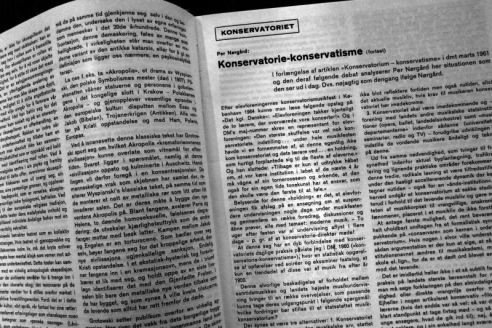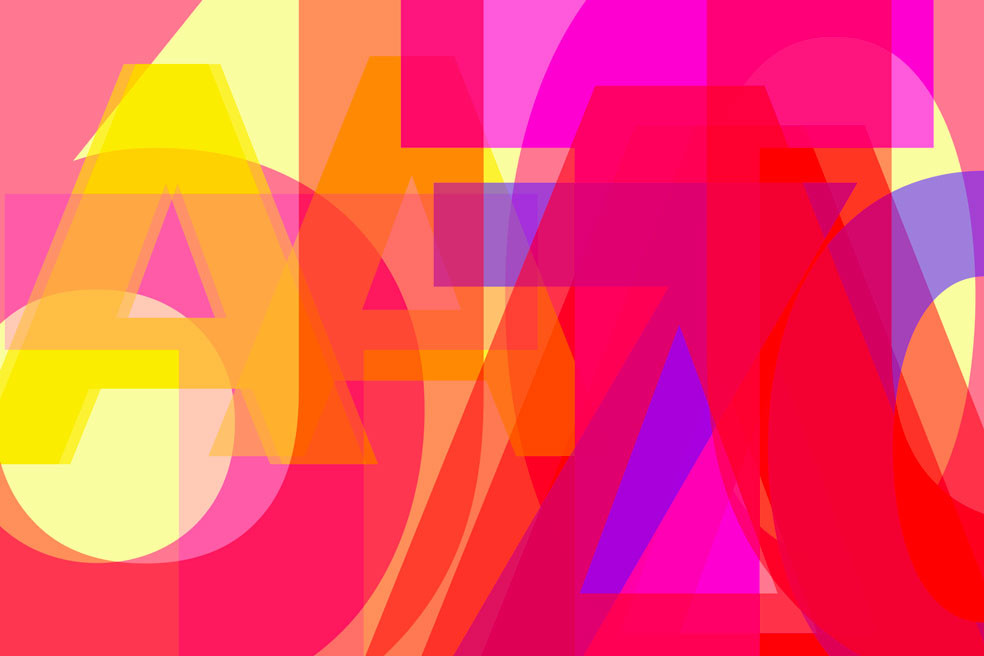In the second half of the 1960’s, a decentralization of the Danish new music scene took place, which was of seminal importance in the decades that followed. It did not happen by chance, but was the result of a number of dedicated individuals’ purposeful work. In 1963, the former Denmark’s Radio program producer, Tage Nielsen, took the post of director at The Royal Academy of Music in Aarhus (RAMA), and he had quite a different attitude to new music and its position in relation to music academy teaching practices than the director of The Royal Danish Academy of Music (RDAM) in Copenhagen. In 1966, the 33-year-old Per Nørgård criticized (in writing) RDAM of ”Conservatory Conservatism”, for the second time. When Nørgård resigned from his job at RDAM in 1965 in protest again the ruling powers’ stance, he was offered a job at RAMA and consequently moved his entire composition class to Aarhus. All of a sudden, there were nine composers affiliated with the conservatory in Aarhus, namely the three teachers: Tage Nielsen, Bent Lorentzen and Per Nørgård and the students: Jens Wilhelm Pedersen (alias Fuzzy), Erik Norby, Gunner Møller Pedersen, Ingolf Gabold, Karl Aage Rasmussen and Ole Buck. Svend Nielsen, who studied music theory in Copenhagen, also attended classes, and later on Timme Ørvad also joined in. In Copenhagen, there was no longer a Chair of Composition and no students.
In Copenhagen, there was no longer a Chair of Composition and no students.
The presence of Per Nørgård’s composition class and the open and accessible atmosphere of the conservatory in Aarhus sparked a wide range of activities, which made new music visible and audible in the growing Aarhus music scene in general. A growing number of RAMA teachers became involved in new music, not least the pianist Bengt Johnsson who motivated his students to play the new works and held courses with among others the famous avant-garde pianist Aloys Kontarsky, who presented Stockhausen’s piano pieces. They were eager to engage guest lecturers. Danish composers included Pelle Gudmundsen-Holmgreen, Mogens Winkel Holm, Poul Rovsing Olsen and Gunnar Berg. Big international names like Lutoslawski, Krenek, Kagel and Ligeti also made appearances as guest lecturers.
AUT comes into being
At the request of theory professor, Mogens Helmer Petersen, an equivalent to Copenhagen-based DUT (Det Unge Tonekunstnerselskab, founded in 1920, ed.) was established in 1966. Aarhus Unge Tonekunstnere (AUT) generated curiosity and received widespread support, also within the university environment. The activities offered during the association’s first season suggest a high level of productivity: The programme did not only include concerts with new Aarhus music by Karl Aage Rasmussen, Ole Buck, Bent Lorentzen, Tom Prehn and Tage Nielsen and others, but also with other new Danish music, for example Ib Nørholm’s 3rd string quartet, Fra mit grønne Herbarium, was performed there when it was under a year old. In addition, significant international works were presented, such as Boulez’s Le marteau sans maître, and not least a memorable concert with the pianist Elisabeth Klein, who in one evening, besides playing Danish new simplicity (Henning Christiansen’s Modeller, Ib Nørholm’s Strofer og Marker and Per Nørgård’s Fragment I-IV), also performed Boulez’s awe-inspiring 2nd piano sonata and dodecaphonic piano music from Israel.
Among other memorable evenings from the first years, I especially remember a concert where Arne Dich played John Cage’s Sonatas & Interludes for prepared piano, while we lay on mattresses on the floor in the music academy’s little hall and looked up at the ceiling. Two slide show series by photographer, Poul Ib Henriksen, featuring images from a traffic intersection in Aarhus, were projected on the wall while the piano sounded out of the speakers.
 Per Nørgård was an avid debater in Dansk Musik Tidsskrift during the 1960s.
Per Nørgård was an avid debater in Dansk Musik Tidsskrift during the 1960s.
British Composers’ Festival
It is indicative of Aarhus’ new status as the centre of new music that in 1970, Edition Wilhelm Hansen organized a big promotion festival for new British music at RAMA with Aarhus participants. The pianist Erik Kaltoft played Roger Smalley’s Piano Pieces I-V, Paul Cooper’s Cycles, as well as piano music by Alexander Goehr, while the Da Camera choir, under my direction, performed choir pieces by Peter Maxwell Davies, John Tavener, Richard Rodney Bennet, Thea Musgrave and Alexander Goehr.
Electronic music
Electronic music had since the 1950’s played an increasingly important role abroad, but on the whole, Danish composers had not yet tuned into the possibilities that it offered. In 1966, Bent Lorentzen however arranged a course in electrophonics for Danish composers as a collaboration between RAMA and Aarhus Teknikum, and participants included Per Nørgård and the group of students and teachers affiliated with him in Aarhus. Bent Lorentzen later released the vinyl record Elektronmusikkens materialer og æstetik (1968) with corresponding textbook material on the subject that was relevant around 1970.
Notably, the world’s first ever multi-programmable synthesizer (called the EEG synthesizer) was developed there.
The growing interest in electronic music finally led to the establishment of the Department of Musical Acoustics under The Institute of Musicology at Aarhus University in 1970. The department was led by Finn Egeland Hansen and focused on both composition and research. Notably, the world’s first ever multi-programmable synthesizer (called the EEG synthesizer) was developed there. It was a monster apparatus that filled the whole auditorium and therefore did not have any particular practical significance.
The essential importance of the musicians
It was of crucial importance that there were so many musicians affiliated to RAMA who were passionate about new music and performed, premiered and not least encouraged the composition of numerous new works. In the piano department, the prominent pianists Erik Kaltoft and Frode Stengaard dazzled with a staggering number of outstanding performances, both alone and as a duo, playing among other things Messiaens’s Visions de l’Amen, Ligeti’s Monument, Selbstportrait und Bewegung, as well as Boulez’s Structures and a number of other avant-garde works for two pianos. Kaltoft played, among other pieces, Messiaen’s comprehensive suites Vingt regards sur l’enfant-Jésus and Catalogue d’oiseaux. The undisputed master of the guitar was Erling Møldrup, who performed just about every piece of new music written for that particular instrument, in addition to documenting the music with numerous recordings on vinyl and CD. Among the singers, Bodil Gümoes in particular made her mark with her performance of new vocal pieces. For a number of years, she was a member of the ensemble Trio Celeste, with Erling Møldrup and percussionist, Einar Nielsen. On the whole, Einar Nielsen was very active and influential in new music as the head of the percussion faculty group, which expanded tremendously under his dynamic leadership.
The most important figure in the new music boom in Aarhus was the composer Karl Aage Rasmussen, who with his knowledge and sense of perspective was behind numerous projects. In 1975, he established the chamber ensemble The Elsinore Players with the participation of Aarhus musicians, modelled on Maxwell Davies’s London ensemble. The ensemble comprised of flute, clarinet, violin, cello, piano, guitar and percussion and with Karl Aage as conductor. The ensemble procured and premiered a number of works by Danish composers over approximately the next ten years, which led to Karl Aage Rasmussen making his name as new music’s organizer in Denmark. Finally, RAMA’s chamber choir, with myself as conductor, performed choir works by Svend Nielsen, Per Nørgård and Swedish avant-garde composers.
The Nørgård concert in Skt. Markus Kirke
In concluding this article about Aarhus as a leading new music city, I would like to mention a most memorable concert that took place in Skt. Markus Kirke on 13 December 1976. This concert had an almost cult-like character and exclusively featured works by Per Nørgård. Visual artist, Morten Skovmand, had made a huge relief entitled Den gyldne Skærm that referenced Per Nørgård’s work Rejse ind i den gyldne Skærm. This relief was placed in front of the altar as the backdrop for the entire event. The concert was arranged by the Da Camera choir, which under my leadership performed Per Nørgård’s Frostsalme for a 16-part choir, probably the most complex choir work ever written, with among other features, a large section for four 4-part choirs in four different intonations and four different rhythms.
... probably the most complex choir work ever written.
The programme also included Nova Genitura by the Renaissance group Sub Rosa, with soprano Bodil Gümoes, recorder player Annette Frisholm, guitarist Maria Kämmerling, violinist Hans Stengaard, gambe player Göran Bergström, harpsichordist Frode Bitsch and percussionist Einar Nielsen. It was in itself remarkable that a Renaissance group played new music. Furthermore, Erling Møldrup performed the guitar piece Genkomster from 1976, Ingelise Suppli Jespersen and Erik Kaltoft performed Nocturner for soprano and piano (1961) and Einar Nielsen played the powerful dramatic percussion piece Waves (1969).
The composer was naturally present himself. Actually – as the above description testifies – a large part of the Aarhus scene’s new music activists were present, and the atmosphere was almost hymnal.


